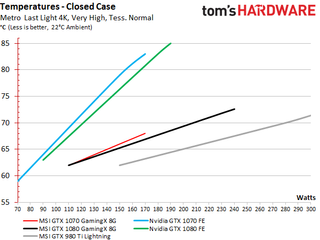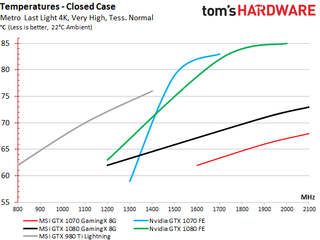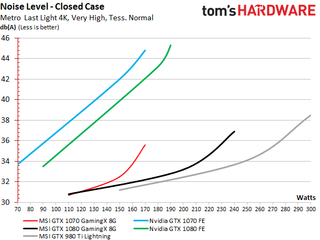Updated: Nvidia GeForce GTX 1070 8GB Pascal Review
Temperature And Noise Results
Temperatures
We start with the direct relationship between power consumption and temperature. Unlike its larger sibling, the Nvidia GeForce GTX 1070 Founders Edition doesn’t have a vapor chamber as part of its cooling solution due to cost-cutting measures. Unfortunately, this fact is reflected in our results. The smaller and more efficient graphics card ends up running at higher temperatures.
Both Founders Edition cards hit their thermal ceilings, capping maximum power consumption. This results in a fairly straight line that doesn't allow us to show each card's limit. We need another set of measurements to illustrate what’s going on.

The following graph shows the ratio of temperature and clock rate. It tells us two things. First, each Founders Edition card demonstrates a clear bend in its curve upon hitting the temperature limit. Second, we see what a good cooling solution that doesn’t hold back its graphics card looks like.

Noise
This section gets more complicated because all of our results were collected in a closed case so far. However, we can’t measure noise like that. So we moved the graphics cards to our audio test station after meticulously recording fan speeds during the preceding benchmarks. We then set each card's fan to the exact same RPM for our audio measurements. The voltage converter noise was below our lower threshold, so we could skip them without really affecting the outcomes.
The results for Nvidia's GeForce GTX 1080 Founders Edition are similar to, but a little different from our launch review. That's a result of higher temperatures in the closed PC case. Once again, we start with the ratio of noise and power consumption.

There’s a huge difference between cards with radial fans and those with several axial fans. Of course, each vendor's fan control curve affects the outcome as well.
MSI is on the conservative side. Its fans only really kick in under high power consumption, and our acoustic readings benefit as a result. Conversely, the two Founders Edition cards always make their presence known, and they can be made out clearly among the other components with high power consumption.
Stay On the Cutting Edge: Get the Tom's Hardware Newsletter
Get Tom's Hardware's best news and in-depth reviews, straight to your inbox.
Once frequency is thrown into the mix, we see a similar picture as before. This includes the same bent curve where the Founders Edition cards run into their thermal limit. We wouldn’t call any of the boards in our comparison annoying-sounding, but MSI does a great job with its three contenders and is the clear winner.

So what does all of this data tell us? First, Pascal’s CUDA cores perform exactly like Maxwell’s. They’re just faster and more efficient. Consequently, the Pascal-based cards post better performance numbers at lower power consumption.
Second, overclocking only makes sense in small doses, if at all. The GeForce GTX 1080 is held back by its slow memory, whereas the 1070 turns out to have the higher memory throughput per shader. Still, both Pascal-based graphics cards are definitely worth a look, and the GeForce GTX 1070 may become a worthy successor to the popular GTX 970 once its prices fall to more reasonable levels and availability improves.
The GeForce GTX 1080 might end up sharing the 980’s fate: it’s just too expensive for the modest performance gain you get compared to GTX 1070. It looks more like a placeholder until the next Titan or GeForce GTX 1080 Ti emerges.
We’re looking forward to what else the add-in partners have in store for us. We’re certain that their R&D departments will find a way around Nvidia’s rules. After all, a full 16W at idle’ is ridiculously high in today’s market.
We received feedback and additional information since the original publication of this article. Unfortunately, the press samples and retail examples of MSI's GeForce GTX 1070 Gaming X 8G and GeForce GTX 1080 Gaming X 8G are slightly different. The press boards default to the OC preset, whereas the retail cards default to the gaming preset with a lower base and GPU Boost clock rate setting.
MSI confirmed all of this and pointed toward the included software. At 20 MHz, the base and GPU Boost frequency differences are not large, but pulling these kind of stunts isn’t fair to customers or the competition. For instance, Gigabyte uses the gaming preset and offers any additional overclocking via software.
MORE: Best Graphics Cards
MORE: All Graphics Content

Redditor allegedly purchased two Intel Arc B570 GPUs at Micro Center days before the official launch — the CPU couldn't recognize the GPUs due to the lack of driver support

Spanish retailer lists RX 9070 and RX 9070 XT GPUs, though the prices might be mere placeholders — RX 9070 for $912 and RX 9070 XT for $1,097
-
adamovera Archived comments are found here: http://www.tomshardware.com/forum/id-3073584/nvidia-geforce-gtx-1070-8gb-pascal-performance-review.htmlReply -
nitrium So given the simultaneously lower price and higher performance of the partner boards, only an actual idiot would buy the "Founder's Edition" GTX 1070?Reply -
George Phillips I feel that I should regret getting MSI 1070 FE. MSI's custom designs perform superior then FE cards in every way. Very impressive. Asus and Gigabyte's custom designs must also do better than FE cards.Reply -
Krushe When you're talking about the heat on FE cards. I think the default fan speed is 45-50% at 83c. Make it 80% and the card never reaches 70c even with boost clock up to 1900+. What speeds are the MSI fans running at during your temp measurements?Reply -
DookieDraws Edit: The article has been updated, so I deleted my original comment about the MSI GPU.Reply -
Tony Casagrande "This means that the lowest possible GPU Boost clock rate step gets eliminated from the bottom of the BIOS’ table. So, if you want an additional space at the top, you need to make room for it by getting rid of the very bottom one."Reply
If it were me, I would have removed a low to middle clock rate instead of the very lowest to get both the low idle power consumption and the OC speed. -
neblogai Regarding the possible audible noise because of power spikes on PEG: it is not really about cheap MB, but about using analog audio out of MB, and not anything digital, right?Reply
Also, about overclocking: I think reviews of all these new generation nVidia and AMD cards should include average clock that cards operated when doing all game benchmarks. Official boost clock numbers are a bit useless, because AMD cards run games at below boost clocks, and average for nVidia GTX1070 is above boost clocks. Having just official boost clock numbers make it difficult to evaluate overclocking potential and make real gains look much bigger or smaller than expected. -
Calculatron Am I the only one that noticed that the Founder's Edition cards managed to pull over 75 watts from the motherboard PCIe slot and that no one went bonkers over it?Reply
Most Popular

